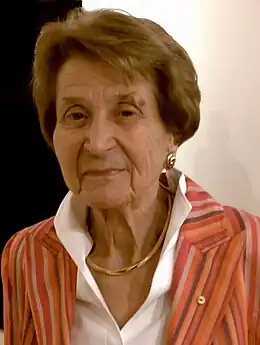Inge King
Ingeborg Viktoria "Inge" King (née Neufeld) le à Berlin (Empire allemand), et morte le à Melbourne (Australie), est une sculptrice germano-australienne[1]. Elle a reçu de nombreuses commandes publiques. Son travail se déroule dans des collections publiques et privées. Son œuvre la plus connue est Forward Surge (1974) au Arts Centre Melbourne. Elle devient membre de l'ordre d'Australie (AM) en .
Les premières années : de Berlin à Melbourne
Berlin
Inge King (née Ingeborg Viktoria Neufeld) à Berlin le , est la plus jeune des quatre filles d'une famille juive[Note 1]. Sa petite enfance est typique d'un enfant de sa classe et de son époque dans une ville européenne. Mais après la Première Guerre mondiale, les conditions de vie en Allemagne deviennent de plus en plus difficiles. La période de la République de Weimar (1918-1933), bien que culturellement stimulante, n'est jamais stable. Les conditions sont rendues plus difficiles par l'hyperinflation du début des années 1920 et la crise de 1929. À cette époque, les choses deviennent de plus en plus difficiles pour la famille Neufeld. Lorsque le père d'Inge King meurt en 1930, alors qu'elle a 14 ans, la famille perd la plupart de son argent. Ses sœurs aînées l'aident à rester à l'école jusqu'à la fin de ses études, en 1932, ce qui lui permet d'obtenir une bonne éducation. Elle aurait aimé aller à l'université, peut-être pour étudier la médecine, mais, financièrement, c'est hors de question[2].
Inge King a 17 ans lorsque Hitler arrive au pouvoir le . Deux de ses sœurs aînées, désormais mariées, décident d'émigrer : l'une en Palestine, l'autre aux États-Unis. En 1934, à l'âge de 18 ans, elle se débrouille seule[3]. Elle part vivre avec d'autres jeunes dans une petite commune sioniste, où elle travaille en échange du gîte et du couvert. Elle dit de cette expérience : « Je leur dois beaucoup... Cette commune ... m'a donné ou appris une certaine indépendance, ce qui est inestimable » et, surtout, lui a appris « à survivre sans argent »[4].
Inge King commence à penser à devenir artiste, bien que ce soit vraiment un second choix. Mais l'art est quelque chose qu'elle peut faire avec des ressources minimales, tant qu'elle peut subvenir à ses besoins. Inge King est influencée à la fois par la sculpture médiévale et par la sculpture expressionniste, partie importante de l'art d'avant-garde allemand, et en particulier par le travail du sculpteur sur bois, Ernst Barlach (1870–1938)[5].
Texte anglais à traduire :
The Nazis considered such art to be decadent (Entartete Kunst) and later attempted to suppress it[6]. King went to see the artist Käthe Kollwitz (1867–1945), whose work she admired. Kollwitz’ advice to King about a career in art was “Don’t do it if you can help it. It is so difficult”. Nevertheless, King did go on. She said: “I haven’t regretted it. I agree with her, it’s difficult.”[7]
King found a teacher, Hermann Nonnenmacher (1892–1988), a wood-carver influenced by Ernst Barlach, who taught her the basic skills of wood-carving and modelling in clay[8]. King worked with him until she was accepted into the Berlin Academy of Fine Arts in 1937, when she was 21, one of only three non-Aryan students there (all women)[9]. She was forced to leave about a year later, not long before Kristallnacht (9–10 November 1938)[8]. While she was there, she supported herself by undertaking commercial work (such as carving architectural ornaments) for the sculptor, Otto Hitzberger (1878–1964), who was on the staff there[10].
King finally got out of Germany in 1939, with the help of German friends. One helped her get a visa for England. Another warned her that he had received his mobilisation papers and that she should leave as soon as possible[8]. She spent about a year in domestic service with families in southern England[11]. She found England far more old-fashioned and conservative than the Berlin she had come from. This was quite a shock.
Traduction du texte anglais :
proposition de traduction
Londres et Glasgow
Elle accepte à la Royal Academy sur la base des dessins qu'elle apporte avec elle et de son séjour à l'Académie des arts de Berlin.
Œuvres principales
Sun Ribbon
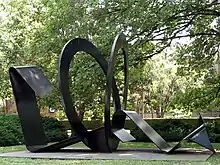
Forward Surge
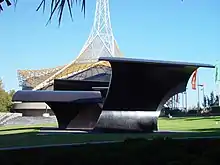
Red Rings
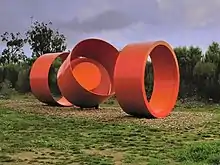
Rings of Saturn
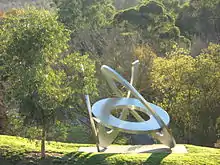
Autres œuvres
- Flower Dancer (1948), National Gallery of Victoria, Melbourne
- Oracle (1966)
- Encounter (1968), université de La Trobe, Melbourne-Bundoora
- Fred Schonell Memorial Fountain (1971), université du Queensland, Brisbane
- Black Sun (1975), National Gallery of Victoria, Melbourne
- Dialogue of Circles (1976), université de La Trobe Sculpture Park, Melbourne-Bundoora
- Temple Gate (1976/1977), Sculpture park in the Galerie nationale d'Australie, Canberra
- Lunar Image (1980), musée et galerie d'art du Territoire du Nord (MAGNT), Darwin, Territoire du Nord
- Jabaroo (1984/1985), McClelland Gallery and Sculpture Park, Langwarrin, Victoria
- Silent Gong (1989)
- Island Sculpture (1991), McClelland Gallery and Sculpture Park, Langwarrin, Victoria
- Guardian Angel (1995), Deakin Museum of Art, université Deakin, Melbourne
- Nayads (1997), Monash Gallery of Art (on loan from National Gallery of Victoria), Melbourne
- Moonbird (1999 commissioned by the Australia Fund), Residence of the Prime-minister, The Lodge, Canberra
- The Sentinel (2000), Eastern Freeway in Melbourne
- Wandering Angel (2000), The Galerie nationale d'Australie, Canberra
- Rings of Jupiter (3) (2006), National Gallery of Victoria, Melbourne
- Red Rings (2008), Eastlink Motorway in Melbourne
Notes et références
Notes
- Son année de naissance est mal donnée dans de nombreuses sources publiées en 1918.
Ces incohérences ont été résolues dans la mesure du possible.Portion de texte anglais à traduire en français
 Texte à traduireTexte anglais à traduire :
Texte à traduireTexte anglais à traduire :
As a result, erroneous dates have been assigned by inference to a number of the events in her early life which, in turn, have led to inconsistencies in accounts of her life.
Traduction du texte anglais :
proposition de traduction
Références
- (en) Cet article est partiellement ou en totalité issu de l’article de Wikipédia en anglais intitulé « Inge King » (voir la liste des auteurs).
- Farewell Inge King
- James Gleeson: Transcript of interview with Inge King, 18 October 1979, for the research library, National Library of Australia, Canberra, 21. Personal details and quotations in the article, unless otherwise noted, have come from pages 21-32 of this transcript.
- Her third sister subsequently died in the holocaust.
- Gleeson 21.
- Judith Trimble: Inge King Sculptor, 2-3.
- Richard J. Evans: The Third Reich in Power, 168-175. A major exhibition of “degenerate art” was held in 1937. The exhibition was enormously popular, attracting more than 2 million visitors (Evans, 173).
- Gleeson, 22-23.
- Trimble, 4.
- Jane Eckett: “Binary Star: Inge and Grahame King”, 3, n.4; also 4, n.8, which refers to records of the "Vereinigte Staatsschulen für freie und angewandte Kunst". In the interview with Stanhope in 2006, King says that she started there in 1936-7, but this may be a mis-remembering.
- Trimble, 4. Also Jane Eckett: “Renewed Vows”, p 5, n 24.
- Eckett, “Binary Star”, 5.
Annexes
Bibliographie
- Sasha Grishin, The Art of Inge King, (2014) Macmillan Art Publishing. (ISBN 978-1-922252-00-5)
- Judith Trimble, Inge King Sculptor, (1996), Craftsman House N.S.W. (ISBN 976-641-048-8)
- Judith Trimble and Ken McGregor, Inge King: Small Sculptures and Maquettes, (2009), MacMillan Mini-Art Series Number 10, Series editor Jenny Zimmer, (ISBN 978-1-921394-26-3)
- Inge King, Sculpture 1945-1982: A Survey. Melbourne University Gallery, The University of Melbourne. Essay by Jenny Zimmer, (1982), (ISBN 0-86839-388-6)
- (en) Grove Art Online, Oxford University Press, (ISBN 9781884446054, lire en ligne)
Film sur Inge King
A Thousand Different Angles, a Frontyard Films documentary on Inge King and her sculpture by Amanda King and Fabio Cavadini was screened on the Australian TV programme Artscape (ABC1, 2010). A five-minute extract is available online from the National Film and Sound Archive.
- (en) « Inge King Sculptor », sur Australian History Timeline, National Film and Sound Archive
Liens externes
- Ressources relatives aux beaux-arts :
- (de + en) Artists of the World Online
- (en) Grove Art Online
- (en) National Gallery of Victoria
- (nl + en) RKDartists
- (en) Union List of Artist Names
- Inge King at the Women's Art Register
- Article in Art Forum
- Capturing the spirit of the times
- Article in The Age
- Exhibition, Commissions and Awards list at Australia Galleries
- The sculpture of Inge King, including her 2009 exhibition "Sculpture: Maquettes and Recent Work"
- Sculpture: 'MoonBird' at the Lodge, Canberra
- Inge King and Grahame King Website
